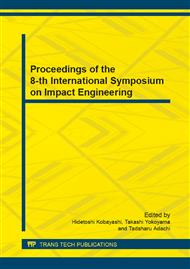p.193
p.199
p.205
p.211
p.219
p.225
p.232
p.238
p.244
Energy Absorption Property of CFRP under Impact Loadings
Abstract:
Because of high stiffness, high strength and low density, etc., polymeric composite materials are widely used in high technology area, such as aeronautic and aerospace engineering where impact is one of the most common loadings. In this paper, impact energy absorption properties of a carbon fiber reinforced plastic (CFRP) plate, which was made through vacuum assisted resin transfer molding (VARTM) process, were tested though Charpy impact tests with single-edge notched specimens. In the experiments, the effects of impact directions and notch length on the energy absorption property were considered. The results show different impact directions lead to different Charpy impact strength and different fracture modes. When the angle between the fiber and the impact direction is large, fiber break mode dominates the break, exhibiting higher Charpy impact strength. When the impact direction-fiber angle is small, delamination is the main fracture mode, showing lower Charpy impact strength. Depending on different fracture modes, the enhancement of the resin due to a post curing process has totally opposite effects on the Charpy impact strength. For the delamination mode, the enhancement of resin increases the Charpy impact strength of the CFRP specimen. However, for the fiber break mode, it decreases the impact strength. This phenomenon can be attributed to the effect of voids. The impact strength calculated from the typical formula is also affected by the initial notch length significantly, because the fracture surface in this experiment is no longer a plane.
Info:
Periodical:
Pages:
219-224
Citation:
Online since:
June 2014
Authors:
Price:
Сopyright:
© 2014 Trans Tech Publications Ltd. All Rights Reserved
Share:
Citation:


